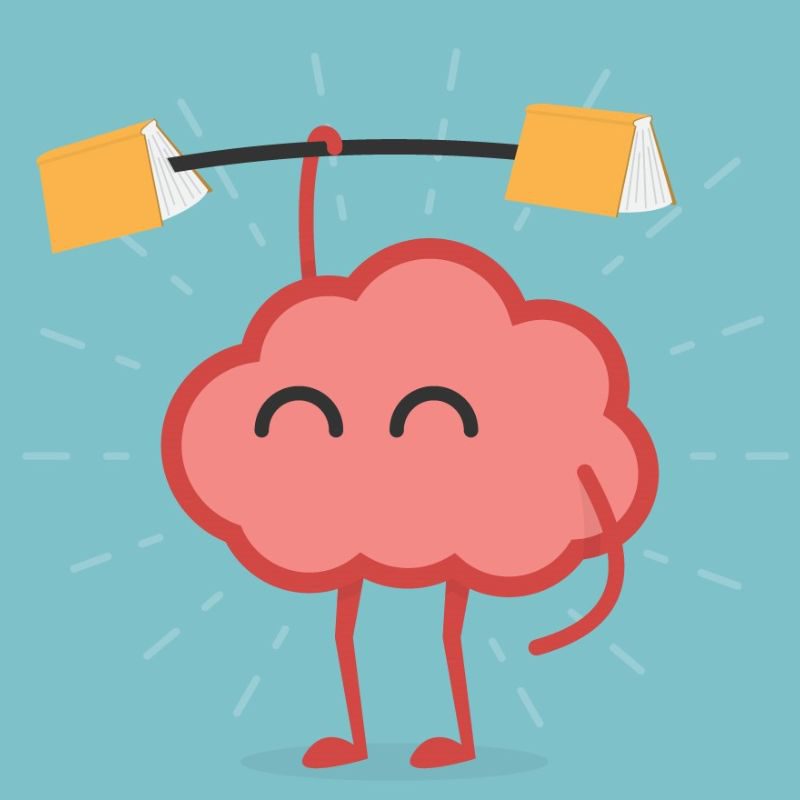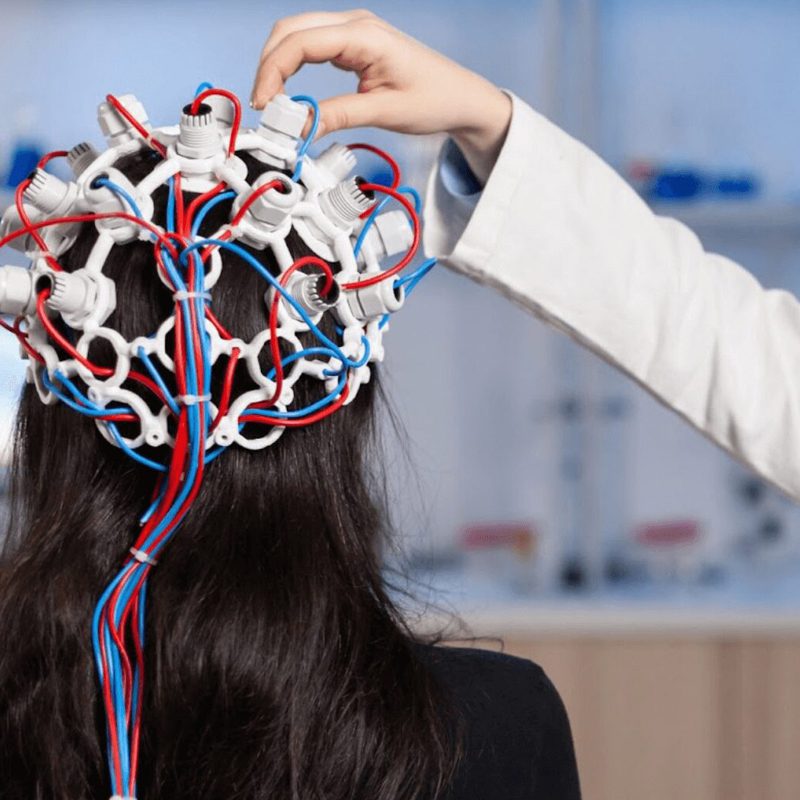Neurofeedback is a type of biofeedback therapy where you learn to control your brain activity to guide it to make permanent changes to function more optimally.
Neurofeedback is a superior methodology because it doesn’t just mitigate the symptoms. It addresses and permanently changes what’s causing the symptoms or problems at the source — in your brain. Your brain learns how to self-regulate in ways that decrease problematic symptoms or behaviors persistently after training. Neurofeedback is non-invasive, painless, and can also be relatively quick when compared to other mental health practices.
Neurofeedback training has many scientifically documented benefits for both the brain and body, including stress reduction, improved sleep, better focus and memory, heightened mental clarity, more emotional and behavioral regulation, enhanced cognitive performance, and more. Our brain training advocates and clients have used neurofeedback to improve and enhance a wide range of physical, emotional, and cognitive abilities with great success.
At Grey Matters of Carmel, we are neurofeedback specialists and have helped hundreds of people’s brains achieve healthier operation over the years. Like any health practice, a person may experience some very mild, transient side effects while undergoing neurofeedback training, which will quickly resolve by themselves. Here’s what you should know and expect.
How Does Neurofeedback Work?
One of our Grey Matters brain advocates will attach quantitative electroencephalogram (qEEG) sensors at predetermined locations on your scalp with conductive paste to measure your brain activity at those specific sites. The sensors feed data to computer software which reads it in milliseconds. This allows the computer to respond almost instantly and sync what’s happening in your brain with what’s happening in the training environment simultaneously.
As part of our survival instinct, our brains are always seeking rewards — originally things like food and mating — to ensure the survival of the species. Neurofeedback leverages this innate drive and during a single neurofeedback session, the brain is given numerous opportunities to self-correct and be rewarded for it. This is called operant conditioning.
When the software reading your brainwaves detects activity outside the optimal levels set by your Grey Matters brain advocate, it stops rewarding your brain. For example, the music or movie quits playing, a Pac-man stops gobbling dots, or a rocket ship stalls. The reward resumes when your brain starts performing within the desired range again. Stopping the reward tells your brain to pay attention and alter its functioning.
With consistent repetition, the brain learns and makes permanent physiological changes to perform more optimally and will continue to make the adjustments outside of the training sessions. All learning occurs at a subconscious level. You don’t actually have to “do” anything. Because it’s a learning process, the results of neurofeedback occur gradually over time.

Neurofeedback Is Exercise for Your Brain
Neurofeedback training is just like exercising any other part of your body. After you go to the gym, a cardio class, or for a run, you may feel tired and sore after. But is this really a side effect or just part of the process of gaining the benefits? You feel this way because you challenged your body and asked it to perform, and it’s responding by getting stronger and building muscle. The soreness is evidence that you accomplished something. Typically, you feel better quickly and are ready to do it again the next day.
The same is true for neurofeedback training — which is, in reality, exercise for your brain. In fact, feeling fatigued after a session is a good sign and to be expected. It means you worked your brain.
Common Side Effects
Because neurofeedback training actually involves your brain making alterations and growing, as with any exercise, there are going to be some side effects. However, rest assured, the common side effects can hardly be classified as negative, and they will naturally resolve quickly on their own. Some of the effects after brain training can include:
- Mental Fatigue: While fatigue is the most common side effect of neurofeedback, it doesn’t usually persist throughout the duration of the entire training schedule, especially when you train with consistent, regular sessions. Your brain uses more energy than any other organ in your body, and it’s going to be using even more than normal when training. Just like working out — the more strength you build, the less fatigue you will experience.
- Stress: During an initial session, it’s common for people to feel a little tense or stressed because brain training is a new experience. Let me reassure you. Neurofeedback training is non-invasive and completely painless. It’s not electrical stimulation or any kind of shock to your brain. In fact, nothing ever goes to or in your brain. Once you are familiar with it, a session can even be relaxing and fun.
- Headaches or Dizziness: Some people experience a minor headache or dizziness while training. Even if you don’t tell us verbally, we will be able to see it in your brain waves. So, don’t be afraid to speak up if you get a headache during a session. We can make adjustments to instantly correct this.
- Distractedness: As patients progress through each level of training, they may notice some sense of distractedness. This feeling is entirely normal and is your brain adjusting. Distractedness and fatigue go hand in hand, so you should expect to experience both. However, you can also expect this side effect to be brief and go away quickly after a session.

Training Location Influences the Side Effects
We want you to feel confident about your brain training, do everything you can to support your brain, and get the best results. Our neurofeedback specialists are highly skilled and will guide you through the entire training process step-by-step. Therefore, your brain health advocate will explain which areas of the brain we are targeting with training and why. They will then customize the training frequencies based on how well your brain is performing and how much of these common effects you are experiencing.
Of course, training certain areas of the brain can result in different side effects, so it is important that you communicate anything you are feeling and experiencing while training.
Here’s How You Can Help Minimize Side Effects
While neurofeedback is non-invasive, we are working with your brain, which means we need to be aware of any neurological conditions you have to minimize any side effects and optimize your individual results. These conditions include things like epilepsy, narcolepsy, migraines, Parkinson’s, multiple sclerosis, ADHD, autism, PTSD, etc. If you’ve had a concussion or other brain injury, the qEEG brain map will detect abnormalities in your brain waves, but it’s best to inform us and give us the details of that or any other condition. We want to know all we can to customize the training to help your unique brain reach its highest potential. This is also a safety precaution so we can adjust your training protocol and frequency.
Here are some things you can do to minimize side effects of neurofeedback training:
- Always work with a qualified professional. Even if you choose not to work with our clinic, you should undoubtedly choose a professional that knows what they’re doing. A trained practitioner understands the brain’s frequencies and how to make the appropriate adjustments for your best outcome.
- Do not overwork your brain. Many people ask us if they can come in every day of the week. While we would love to agree, this just isn’t practical and could limit your brain’s progress. Just like your muscles, your brain can only handle so much change and information at one time. Spacing out your training sessions gives your brain enough time to rest and use the new pathways created. Also, on the days you train, if at all possible, it’s best to avoid other mentally taxing activities for long periods of time.
- Eat healthy foods. Your diet has a huge influence on the operation of your brain all of the time, and especially when undergoing neurofeedback training. You will want to support your brain by giving it the nutrition and energy it needs to make beneficial changes. Eating a diet that includes healthy fats, lots of protein, leafy greens, vegetables and berries, and whole grains is a good idea for most people and should minimize the side effects, including fatigue.
- Get lots of quality sleep. During sleep your brain processes information, consolidates memories, makes connections, and clears toxins. Your brain makes permanent what was learned in that day’s training session during that night’s sleep. So, it’s imperative that you get seven to nine hours of sleep while training.
See the Benefits of Neurofeedback in Your Own Life
At Grey Matters of Carmel, we want you to help you be your best self and live your best life. Neurofeedback training can help you get there by guiding your brain to optimal performance.
When your brain works better, your life works better.
Neurofeedback is scientifically proven to improve the symptoms of anxiety, depression, PTSD, migraines, ADD/ADHD, autism, apraxia, concussion, brain injury, IBS and leaky gut, and much more. Please contact us or give us a call at (317) 215-7208 today to learn how we can improve your brain and life.
First image: Image by DCStudio on Freepik
Second image : Image by dooder on Freepik


